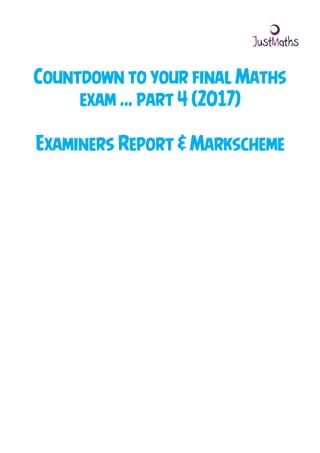
Part 4 final countdown - mark scheme and examiners report
- 1. Countdown to your final Maths exam … part 4 (2017) Examiners Report & Markscheme
- 2. Examiner's Report Q1. Pythagoras' Theorem questions are also firm favourites on these papers and here again candidates did not score as well as they might have done. They made the usual mistakes of doubling instead of squaring, dividing by 2 instead of square rooting, adding the lengths instead of the squares of the lengths and even subtracting the squares of the given lengths. There was some evidence of candidates trying to use scale drawing but these were almost always unsuccessful as the required accuracy of the answer was too great for their drawing. Q2. No Examiner's Report available for this question Q3. No Examiner's Report available for this question Q4. No Examiner's Report available for this question Q5. The majority realized that the diagonal was to be found using Pythagoras. Weaker candidates doubled rather than squaring in calculating Pythagoras. Those who failed to choose Pythagoras as a method either guessed the length of the diagonal, or estimated its length from the two given sides. If made clear, they could then gain some credit from calculating the total of their six lengths. Q6. No Examiner's Report available for this question Q7. Candidates understood they had to find the missing side AB in this right angled triangle but often just added the two sides of 32 and 24. Only about a third of candidates realised they had to square and add the lengths if the right angled triangle with many subtracting instead. In part (b) a lot of the candidates assumed they had to find the areas of the two mirrors rather than find the perimeter of the mirrors and so scored no marks. Very few candidates were able to give a fully correct solution to this question though partial credit was often earned for trying to find the circumference of the circle and the perimeter of the triangle. Those who did try to find the perimeter did not take account of the fact that the metal strip is sold in lengths of one metre when trying to find the cost. Most candidates did not associate part (a) with part (b). Q8. This question was designed to assess the Theorem of Pythagoras in a functional setting which required students to communicate their working and to reach a conclusion. Only a minority of students recognised this. Those that did work out the missing side from 102 + 72 generally progressed to get full marks, although one or two miscalculated the perimeter by adding on the extra 7 they had written down to find the missing side or adding the perimeter of the rectangle they had drawn to the perimeter of the triangle they had used. Some students wrote down 12 after finding √149. They then used the 12 to find that the perimeter was 51 m and reach a suitable conclusion about the fence. This was allowed as being an appropriate course of action in this case. Many students had no feel for the problem at all and attempted to calculate areas – often they thought the demand was about using the trapezium rule so demonstrating they had no understanding of the difference between area (the amount of space inside a region) and perimeter (the total length of all of the edges of the region) Q9. No Examiner's Report available for this question Q10. This question was poorly done except by the most able candidates. The vast majority only managed to gain the first method mark for Pythagoras and generally AC = 5. Very few recognised the need to use trigonometry and many attempted to use the cosine formula badly. Of those who did use trigonometry, the sine rule was seen most commonly. Q11. This question was well attempted and blank responses were rare. Despite the circle most candidates realised that Pythagoras was needed to find the diameter and then went on to find the circumference though a few stopped after finding the diameter forgetting that the question required them to find the circumference. Students were confusing circle formulae and some were finding the area or misremembering the formula completely. The small number of students lost one mark due to premature rounding of their value for the diameter. Only the very weakest students were failing to score any marks usually due to not using Pythagoras at all.
- 3. Q12. No Examiner's Report available for this question Q13. No Examiner's Report available for this question Q14. This question was poorly answered. Many gained 1 mark for finding the area of the circle but finding the area of the square proved to be beyond the majority of students. An incorrect method of 6 × 6 was frequently seen but less understandable on a Higher tier paper was the number of students who worked out 6+6+6+6 or 6×6×6×6 for the area. Some students worked out the area of the square by first finding the area of one of the triangles and some used Pythagoras's theorem to find the side length of the square. Those using Pythagoras sometimes rounded the side length before working out the area of the square and lost accuracy. It is disappointing when students fail to understand that (√72)2 gives 72, not 71.9 or a similarly rounded figure. Some students found an area for the square that was greater than the area of the circle and went on to subtract the area of the circle from the area of the square. Q15. No Examiner's Report available for this question Q16. No Examiner's Report available for this question Q17. No Examiner's Report available for this question
- 8. Q17. Q18.
